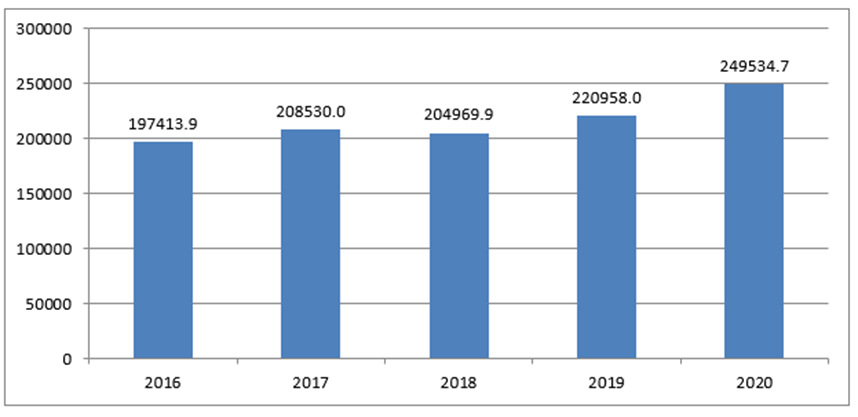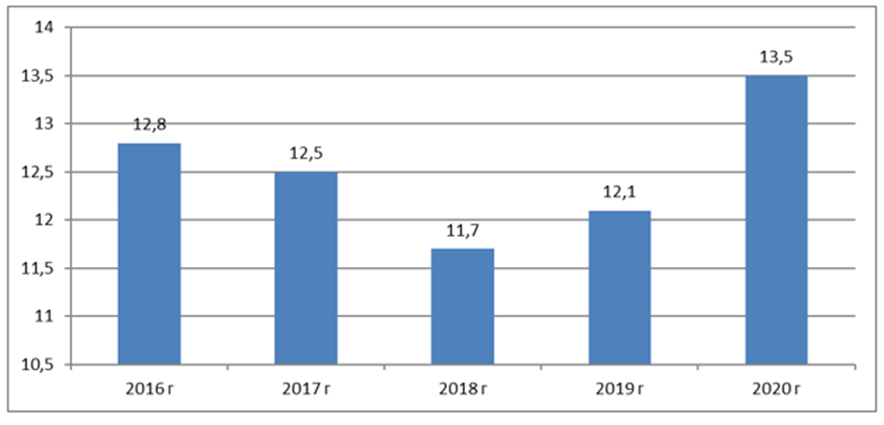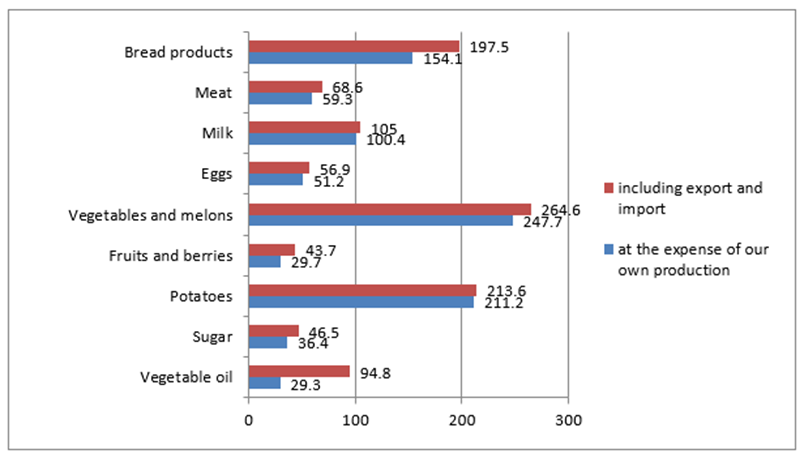Problems of ensuring food security of the Kyrgyz Republic
Introduction.
Food security is one of the main directions of ensuring the national security of the country, a factor in preserving its statehood and food independence [1].
In the sphere of agriculture of the Kyrgyz Republic, there are more than 462129 small commodity producers, which produce more than 95,9% of the total output [3]. Agricultural producers are insufficiently provided with irrigation, plant protection and veterinary services, seed and breeding services and technical services. They face difficulties in storage, processing and sales of products due to the lack of special equipment and innovative technologies, reduction of cultivated areas and poor communication with processing and trading enterprises. As a result, in the agricultural sector of the Kyrgyz Republic, there are incomplete food security, low quality of agricultural products and low volume of processing of agricultural raw materials. The consequence of the limited volumes of domestic production of basic food security products is the keeping the high level of dependence of the Kyrgyz Republic on imports and small volumes of export supplies.
For FAO, food security exists when all people, at any time, have physical, social and economic access to safe and nutritious food in sufficient quantity that meets their nutritional needs and tastes for an active and healthy lifestyle [2].
Ensuring food security is a priority of public policy, as it covers a wide range of national, economic, social, demographic and environmental factors. In the area of food security, the key problems of agro-industrial and economic reforms, objective trends in the development of agricultural and food production, the domestic market, the degree of its dependence on the world food market intersect.
The government should increase domestic production of agricultural products in the country to ensure food security.
Methods.
For the purposes of the research scientific and statistic methods of system analysis were used. A literature review in the field of food security, agricultural production was conducted, the results of reports and policy briefs on the evaluation of assessment of the level of food security were studied.
Results and discussion.
The gross output of agriculture, forestry and fishery products in 2020 was 249534.7 million soms, while the physical volume index was 101% compared to the previous year (picture1) [3].

Picture 1 — The gross output of agriculture, forestry and fishery products, mln.soms
Growth in gross output of agricultural products in 2020 can be explained by both an increase in livestock production and crop production.
In the total volume of agricultural production in 2020, livestock products accounted for 46.6%, plant growing -50.4%, forestry and fishing — 0.5%, and services — 2.5%. 95% fell on the share of peasant (private) farms and personal subsidiary farms of citizens in the total volume of production.
As of January 1, 2021, more than 462000 active economic entities operating in the fields of agriculture, forestry and fishery are registered on the territory of the republic (table 1).
Among them, about 349159, or 75.5% of the total number of such subjects, fell on peasant (farm) farms, 112422 subjects, or 24.3% — on individual entrepreneurs engaged in agricultural production.
Table 1.
Number of operating economic entities of agriculture, forestry and fisheries
| 2016 | 2017 | 2018 | 2019 | 2020 | |
| Total | 415509 | 429291 | 440316 | 453127 | 462483 |
| State farms | 33 | 27 | 26 | 31 | 31 |
| Collective farms | 481 | 460 | 427 | 464 | 517 |
| Peasant (farm) farms and personal subsidiary farms of citizens | 414919 | 428730 | 439602 | 452308 | 461581 |
| Forestry | 53 | 53 | 62 | 112 | 116 |
| Fishery | 23 | 21 | 199 | 212 | 238 |
The share of the gross value added of agricultural, forestry and fishery products in 2020 in the GDP of the republic is 13.5%, which is 1.4% higher than in 2019 and 0.7% higher than in 2016 (picture 2).

Picture 2 — The gross value added of agricultural, forestry and fishery products (in % of GDP)
The largest share in the total volume of gross output of agriculture, forestry and fisheries in 2020 was accounted for by farms in Chui (25.2%), Osh (19.8%) Jalal-Abad (17.9%), Issyk-Kul (13.8%) and Talas (8.9%) regions.
Growth in gross output of agricultural products in the past year was due to an increase in livestock production by 2.0%.
In the total volume of gross output of agriculture, forestry and fisheries, the largest share (more than 24%) belongs to Chui oblast.
Table 2
Comparison of different norms and levels of consumption of basic food products in the Kyrgyz Republic (kg/year)
| Bread products | Potatoes | Vegetables and melons | Fruits and berries | Meat | Milk | Eggs, pieces | Sugar | Vegetable oil | ||
| Minimum norm of consumption per capita in the Kyrgyz Republic (approved by Jogorku Kenesh of the Kyrgyz Republic from 09.06.06 №. 1088) | kg/year | 89,1 | 57,3 | 150,3 | 112,4 | 39,1 | 184,8 | 166 | 21,7 | 9,6 |
| Average physiological norm of consumption per capita in the Kyrgyz Republic (approved by the Government of the Kyrgyz Republic on 19.02.2010 №111) | kg/year | 115,3 | 98,6 | 114,3 | 123,7 | 61,3 | 200 | 182,5 | 25,6 | 9,1 |
| The actual level of consumption calculated by the NSC of the KR в 2020 year | kg/year | 160,8 | 106,8 | 175,2 | 32,4 | 42,0 | 213,6 | 98,4 | 12,0 | 7,2 |
Analyzing the data of the Table 2, it can be concluded that the population consumes cheaper food products such as bread and bakery products (in terms of grain) by 45.5 kg, vegetables by 60.9 kg, potatoes by 8.2 kg and milk and dairy products by 13.6 kg more than the average physiological norm. At that time, the actual level of consumption for more expensive food remains low. Thus, we consume less meat for 19.3 kg, fruits and berries — 91.3 kg, eggs — 84.1 pieces. This suggests that we have a low purchasing power.

Picture 3 — Provision of food security on average/medium-physiological norm by means of our own production and including export and import for 2020, %
In 2020, the security of the domestic food market including export and import was: bread products — 197.5%, potatoes — 213.6%, milk — 105%, meat — 68.6%, vegetables and melons — 264.6%, fruits and berries — 43.7%, eggs — 56.9%, vegetable oil — 94.8%, sugar — 46.5%. And at the expense of our own production, as we can see the percentage of security is much lower for those groups of products for which we are import-dependent. At the same time, the share of imports in the volume of the domestic market was 43.4% for bakery products, 9.6% for meat, 65.5% for vegetable oil, 10.1% for sugar, 14% for fruits and berries.
One of the main tasks for the development of the food processing industry is to increase the competitiveness of agricultural products and its processed products by increasing the efficiency of state support, technical and technological re-equipment of production, transition to international standards of quality. It will help to improve the quality of domestic products, expand the range of food products, and thereby, create equal conditions for competition with our trading partners of EurAsEC.
Conclusion.
In order to ensure food security, state policy should be implemented in several areas: in the sphere of increasing economic and physical accessibility; forming state reserves in the right amounts; increasing the production of agricultural products; developing measures of flexible customs and tariff regulation in order to ensure food security and protect the interests of domestic producers; ensuring the effective operation of the system of veterinary and phytosanitary control taking into account international rules and standards; and improving the regulations in the agricultural sector.
Thus, it is necessary to further consider the following issues:
— increasing the production of agricultural products through the use of innovative agro-technologies;
— creation of special laboratories for determining the quality of agricultural products of animal and plant origin, processed products that meet the requirements of international standards;
— creation of modern logistics centers.
Библиографический список
1. Программа продовольственной безопасности и питания в Кыргызской Республике на 2019-2023 годы.https://www.fao.org/faolex/results/details/en/c/LEX-FAOC195970/
2. Our road to achieving SDG2 with food security. https://www.kg.undp.org/content/kyrgyzstan/en/home/presscenter/articles/2021/07/our-road-to-achieving-sdg2-with-food-security.html
3. Информационный бюллетень по продовольственной безопасности и бедности - Б.: Нацстатком Кыргызской Республики, 2/2021 – 68 с.
http://www.stat.kg/media/publicationarchive/c2680b6f-7b4a-4791-a500-df3181c42af5.pdf
4. Информационный бюллетень по продовольственной безопасности и бедности - Б.: Нацстатком Кырг.Респ., 4/2021 – 65 с. http://www.stat.kg/media/publicationarchive/b1134c7e-a2a5-4bd7-b503-4b4ad7dcdda8.pdf
5. Информационный бюллетень по продовольственной безопасности и бедности - Б.: Нацстатком Кырг.Респ., 1/2021 – 62 с.
http://www.stat.kg/media/publicationarchive/b9fca078-7b1e-4f8b-81b2-70b36565261a.pdf
6. Сборник Национального статистического комитета КР «Сельское хозяйство Кыргызской республики 2016-2020 гг.». Бишкек, 2021. http://www.stat.kg/ru/publications/sbornik-selskoe-hozyajstvo-kyrgyzskoj-respubliki/
7. Социально-экономическое положение КР, Бишкек, 2021 (Январь-декабрь) http://www.stat.kg/ru/publications/doklad-socialno-ekonomicheskoe-polozhenie-kyrgyzskoj-respubliki/
